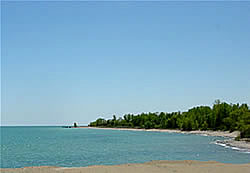- ATSDR’s Exposure Investigation Report Illinois Beach State Park (October 2007)

The Adeline Jay Geo-Karis Illinois Beach State Park (IBSP)
The state considers the park a unique natural resource, one with the only remaining Lake Michigan beach ridge shoreline in the state. Glacial advance and retreat created the area and left dunes, swales, marshes, and a variety of wildlife and vegetation. Before it became a state park, the military used the area for training. In 1948, Illinois acquired the first parcels of what is now IBSP.
In late 1997, pieces of transite pipe, siding, and roofing materials suspected of containing asbestos were found scattered along the beach. In February 1998, the Illinois Department of Natural Resources (IDNR) collected two bulk samples of the material and found they contained asbestos fibers. Following this discovery, IDNR began an investigation to determine the extent and possible source of asbestos contamination at the park.
How is ATSDR Involved in This Site?
In 2000, the Illinois Department of Public Health (IDPH) prepared a public health assessment of IBSP published by ATSDR. This project was conducted under a cooperative agreement between IDPH and ATSDR. In the health assessment, IDPH recommended that warning signs and flyers be posted to alert the public about the possible presence of asbestos materials on the beach, periodic beach inspections be conducted, and any asbestos-contaminated materials found be removed.
In June 2005, the Great Lakes Center for Excellence in Environmental Health at the University of Illinois-Chicago (UIC) School of Public Health asked the Agency for Toxic Substances and Disease Registry (ATSDR)
to comment on their draft report, Illinois
Beach State Park (IBSP): Determination of Asbestos Contamination in Beach Nourishment Sand,
Final Report [PDF, 501 KB]![]() .The UIC researchers evaluated the levels of asbestos in various beach areas at IBSP, comparing the results to other beaches on the southwestern shoreline of Lake Michigan. Results of this study found statistically elevated levels of asbestos structures in the sand in IBSP North unit sand relative to background levels at other beaches; however, the estimated levels of asbestos
exposure were below the risk levels used by the U.S. Environmental Protection Agency (EPA) as a threshold for taking protective action. Overall, ATSDR scientists agreed with the conclusions of the UIC study’s risk assessment; however, ATSDR reviewers felt that there were some uncertainties in the study’s exposure assessment. Accordingly, ATSDR recommended activity-based sampling to confirm UIC findings.
.The UIC researchers evaluated the levels of asbestos in various beach areas at IBSP, comparing the results to other beaches on the southwestern shoreline of Lake Michigan. Results of this study found statistically elevated levels of asbestos structures in the sand in IBSP North unit sand relative to background levels at other beaches; however, the estimated levels of asbestos
exposure were below the risk levels used by the U.S. Environmental Protection Agency (EPA) as a threshold for taking protective action. Overall, ATSDR scientists agreed with the conclusions of the UIC study’s risk assessment; however, ATSDR reviewers felt that there were some uncertainties in the study’s exposure assessment. Accordingly, ATSDR recommended activity-based sampling to confirm UIC findings.
IDNR requested ATSDR’s support in planning an activity-based sampling effort at IBSP. This investigation presented an opportunity for ATSDR to work collaboratively with the IDNR and the IDPH to help address the issues raised by ATSDR’s review of the UIC report. ATSDR released this report in October 2007.
A review of ATSDR’s exposure investigation report by the EPA Technical Review Workgroup for Asbestos acknowledged that the range of potential exposures had been properly evaluated. However, the workgroup recommended additional sampling using a scenario that may reflect intensive recreational activities, as a way to better characterize actual exposures. EPA conducted this sampling in early September 2007 and asked ATSDR to help evaluate the sampling results. ATSDR anticipates releasing this evaluation before summer 2008.


